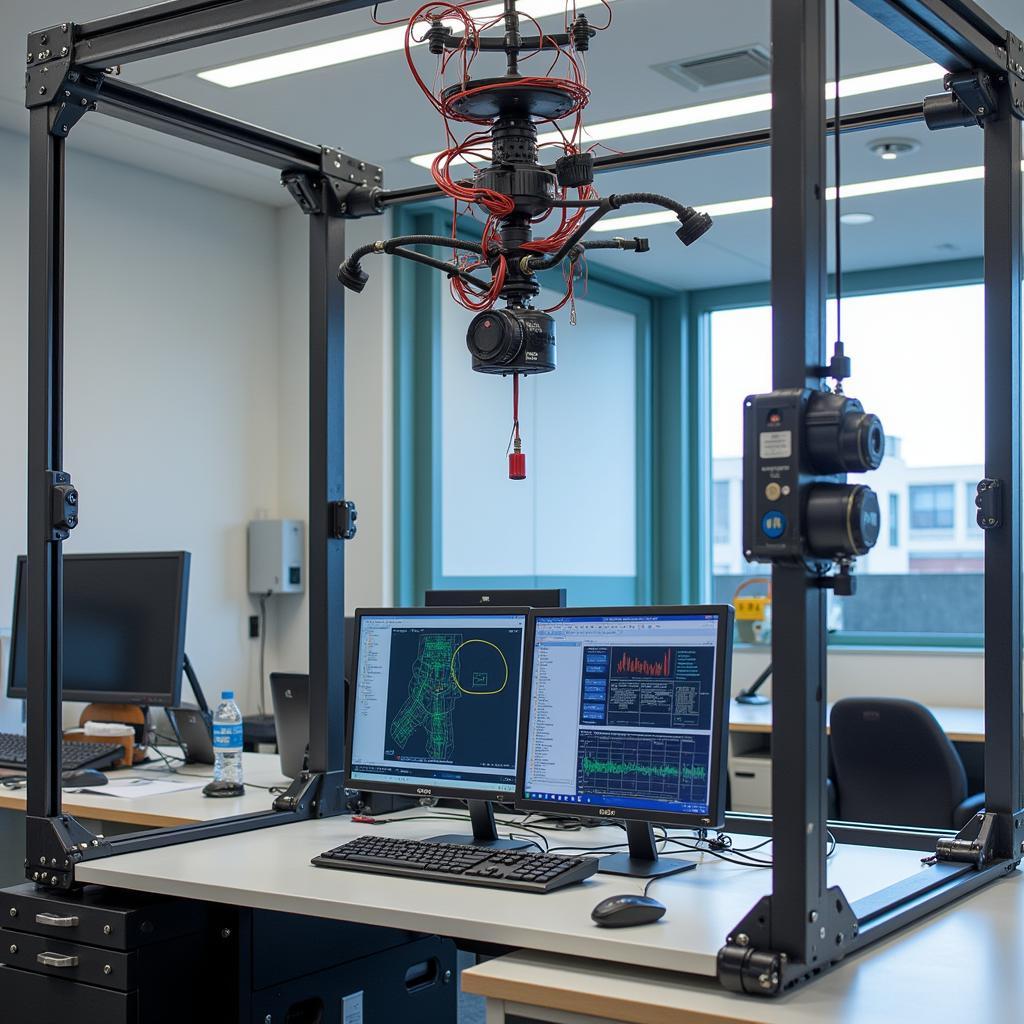A Free Fall Apparatus is a crucial piece of equipment used in physics experiments to demonstrate the principles of gravity and acceleration. Understanding its function and applications provides valuable insights into the fundamental laws governing motion. This article will delve into the intricacies of the free fall apparatus, exploring its various types, uses, and the scientific concepts it helps illustrate.
Exploring the Different Types of Free Fall Apparatus
Free fall apparatuses come in various forms, each designed for specific experimental purposes. Some common types include:
- The Atwood Machine: This classic device utilizes two masses connected by a string passing over a pulley. By varying the masses, one can observe the effects of different forces on acceleration during free fall.
- Drop Tower: Drop towers offer a controlled environment for studying free fall over longer distances. Objects are dropped from a significant height, allowing researchers to gather precise data on acceleration and air resistance.
- Digital Free Fall Apparatus: This modern version incorporates digital sensors and timers to provide accurate measurements of time and distance, enhancing the precision of experimental data.
These are just a few examples of the different types of free fall apparatuses used in scientific investigations. Each type offers unique advantages and capabilities, catering to specific experimental needs.
How Does a Free Fall Apparatus Work?
The basic principle behind a free fall apparatus is to create a controlled environment where an object can fall freely under the influence of gravity, minimizing external forces like air resistance. The apparatus typically includes a release mechanism that allows the object to drop from a predetermined height. A timing mechanism accurately measures the time it takes for the object to fall a certain distance. This data is then used to calculate the acceleration due to gravity.
Applications of the Free Fall Apparatus in Physics Education
Free fall apparatuses are invaluable tools in physics education. They provide students with hands-on experience in observing and measuring the effects of gravity. Experiments conducted with these devices help solidify understanding of fundamental concepts such as:
- Acceleration due to Gravity: Observing the constant acceleration of an object in free fall provides a direct demonstration of gravity’s influence.
- Newton’s Laws of Motion: Studying the relationship between force, mass, and acceleration reinforces Newton’s Second Law.
- Air Resistance: By comparing the free fall of objects with different shapes and sizes, students can investigate the impact of air resistance on falling bodies.
These experiments allow students to apply theoretical knowledge to practical scenarios, fostering a deeper understanding of the laws of physics.
What is the Importance of a Free Fall Apparatus?
The free fall apparatus is more than just a piece of lab equipment. It’s a gateway to understanding the fundamental forces that shape our universe. Its importance lies in its ability to:
- Provide Empirical Evidence: The apparatus allows for direct observation and measurement of the effects of gravity, providing empirical evidence to support theoretical concepts.
- Enhance Conceptual Understanding: Hands-on experimentation fosters a deeper understanding of complex physical phenomena.
- Promote Scientific Inquiry: Using the apparatus encourages critical thinking and problem-solving skills, fostering a spirit of scientific inquiry.
Dr. Amelia Hernandez, a renowned physicist at the California Institute of Technology, emphasizes the educational value of these devices: “The free fall apparatus is an indispensable tool for teaching physics. It bridges the gap between theory and observation, allowing students to witness the laws of physics in action.”
Free Fall Apparatus: A Tool for Scientific Discovery
Beyond its educational applications, the free fall apparatus continues to play a role in scientific research. It’s used in various fields to:
- Test Gravitational Theories: Precise measurements of free fall can be used to test and refine theories of gravity.
- Study Aerodynamics: Analyzing the motion of objects in free fall helps researchers understand the principles of aerodynamics.
- Develop New Technologies: Insights gained from free fall experiments can inform the development of new technologies in areas such as aerospace engineering.
 Free Fall Apparatus in Scientific Research
Free Fall Apparatus in Scientific Research
Professor David Lee, a leading researcher in experimental physics at MIT, states, “The free fall apparatus remains a valuable tool for exploring the fundamental laws of nature. Its versatility and precision make it an essential instrument for scientific discovery.”
Conclusion
The free fall apparatus is a powerful tool for understanding the principles of gravity and motion. From its use in educational settings to its role in scientific research, the free fall apparatus continues to provide valuable insights into the fundamental forces that govern our universe. Its versatility and precision make it an essential instrument for both teaching and discovery.
FAQ
- What is the purpose of a free fall apparatus?
- What are the different types of free fall apparatuses?
- How is a free fall apparatus used in physics experiments?
- What are the key concepts illustrated by a free fall apparatus?
- How does a free fall apparatus contribute to scientific research?
- What are the benefits of using a digital free fall apparatus?
- How does air resistance affect free fall experiments?
Need support? Contact us at Phone Number: 0972669017, Email: [email protected] Or visit us at: 142 Trần Nhân Tông, Yên Thanh, Uông Bí, Quảng Ninh, Việt Nam. We have a 24/7 customer support team.